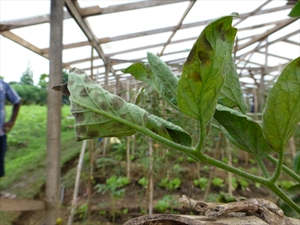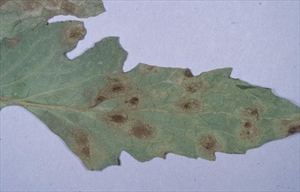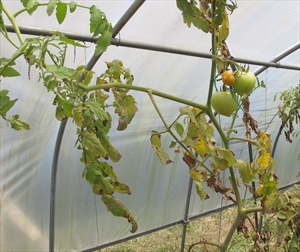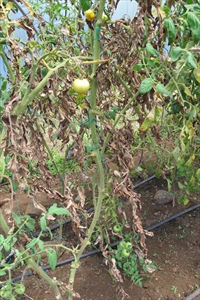Black leaf mould, leaf spot, tomato leaf mould
Pacific Pests, Pathogens and Weeds - Online edition
Pacific Pests, Pathogens & Weeds
Tomato black leaf mould (045)
Pseudocercospora fuligena. Previously, known as Cercospora fuligena.
Asia, Africa, North (restricted) and South America, the Caribbean (restricted), Oceania. It is recorded from Australia, Cook Islands, New Caledonia, Palau, Papua New Guinea, Solomon Islands, and Vanuatu.
Tomato, capsicum, chilli, and eggplant.
The disease starts on the older leaves and spreads upwards. The first signs are irregular yellow patches with indistinct margins on both sides of the leaves (Photo 1). Those on the lower surface develop a brown or dark brown mould containing the spores (Photos 2&3). The spots join together and the leaflets rapidly dry, die and the leaves hang down (Photos 4&5). Later, they fall off. There are no symptoms on the fruit.
The spores are spread by wind-blown rain, and if windy wet weather continues for a few days, spread is fast and plants defoliate rapidly.
The source of the fungus is from other infected crops, the remains of the previous crop and, perhaps, other host species. The fungus is not seed borne.
The fungus causes plants to lose their leaves. If infection occurs before the fruit has developed, yields are low. This is an important disease on tomato in Solomon Islands.
Look for the disease on the bottom leaves. Look for the yellow spots on the upper leaf surface, and the brown mould-like spore masses, mostly on the under surface of the older leaves.
Note, there is another disease that has similar symptoms. It is called tomato leaf mould, caused by the fungus, Passalora fulva (see Fact Sheet no. 76). This fungus and Pseudocercospora fuligena can only be distinguished by looking at their spores under a microscope.
CULTURAL CONTROL
Cultural control is important. The following should be done:
Before planting:
- Do not plant new crops next to older ones that have the disease; otherwise, spread of the disease to the new crop will be rapid and significant.
- Practice crop rotation. Do not plant one crop of tomato after another on the same land.
- Leave at least 3 years between crops after the disease has occurred.
During growth:
- Do not use overhead irrigation; otherwise, it will create conditions for spore production and infection.
- Remove a few branches from the lower part of the plants to allow better airflow at the base.
- Remove and burn the lower leaves as soon as the disease is seen, especially after the lower fruit trusses have been picked.
After harvest:
- Collect and burn as much of the crop as possible when harvest is complete.
RESISTANT VARIETIES
There are varietal differences in susceptibility to Pseudocercospora fuligena, and trials are being done in Solomon Islands testing lines from AVRDC (The World Vegetable Center, Taiwan).
CHEMICAL CONTROL
Warm wet conditions in Pacific island countries favour the disease such that fungicides are needed to give adequate control. The products to use are chlorothalonil, copper oxychloride or mancozeb. Treatment should start when the first flowers appear, and continue at 10-14 days intervals until 3-4 weeks before last harvest. It is important to spray both sides of the leaves.
____________________
When using a pesticide, always wear protective clothing and follow the instructions on the product label, such as dosage, timing of application, and pre-harvest interval. Recommendations will vary with the crop and system of cultivation. Expert advice on the most appropriate pesticide to use should always be sought from local agricultural authorities.
AUTHORS Helen Tsatsia & Grahame Jackson
Information from CABI (2020) Pseudocercospora fuligena (black leaf mould). Invasive Species Compendium. (https://www.cabi.org/isc/datasheet/12222); and (with Photo 5) McKenzie E (2013) Pseudocercospora fuligena. PaDIL - (http://www.padil.gov.au). Photos 1&2 Jaw-Fen Wang, AVRDC, The World Vegetable Center, Taiwan.
Produced with support from the Australian Centre for International Agricultural Research under project PC/2010/090: Strengthening integrated crop management research in the Pacific Islands in support of sustainable intensification of high-value crop production, implemented by the University of Queensland and the Secretariat of the Pacific Community.








